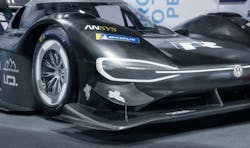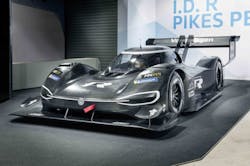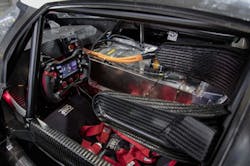Volkswagen motorsport recently introduced its fully-electric supercar—the I.D. R Pikes Peak. The supercar will compete in the Pikes Peak International Hill climb in Colorado Springs, Colo., on June 24, seeking to beat the existing electric car record of 8:57.118 minutes in the annual “Race to the Clouds.” I.D. R Pikes Peak weighs less than 2,500 lbs and produces 680 hp and 479 lb-ft of torque, giving it a 0-60 time of 2.25 seconds—faster than even Formula 1 and Formula E cars.
“Volkswagen’s goal is to reach the pinnacle of electromobility with the I.D. family,” says Dr. Frank Welsch, Volkswagen Member of the Board of Management with responsibility for Development. “The hill climb on Pikes Peak will definitely be a real acid test for the electric drive. Customers have always benefited from the findings made in motorsport, and we expect to take these findings and use them as a valuable impetus for the development of future I.D. models.”
The main goal when developing the Volkswagen I.D. R Pikes Peak wasn’t on maximum performance, as is usually the case with racing cars, but rather to find the ideal balance between energy capacity and weight. Volkswagen’s prototype for Pikes Peak bears two quality seals in its name: the “R,” which is synonymous with performance cars, and “I.D.”—a symbol of Volkswagen’s smart E-technology.
Generating the Power
Like the twin-engine Golf that took on the Pikes Peak challenge in 1985, 1986, and 1987, the engineers have opted for a solution with two power units. The I.D. R Pikes Peak features two electric engines, generating a system capacity of 680 hp.
Lithium-ion batteries are used as the energy-storage system, similar to production EVs. Their power density is the crucial factor for the system when producing high voltage. Roughly 20% of the electric energy required is generated during the drive, so the key here is energy recovery. When braking, the electric engines act as generators, converting some of the braking energy into electricity and feeding this into the battery.
Interior of Volkswagen's I.D. R Pikes Peak
Volkswagen’s Pikes Peak program enters a crucial phase of testing. The 12.42-mile route of the hill climb in Colorado Springs is very limited, and only possible on certain sections, the bulk of the testing isn’t done on the actual route, but at racetracks. With the vehicle revealed to the world, testing can commence.
World-class driver and defending Pikes Peak champion, Romain Dumas, will drive the Volkswagen I.D. R Pikes Peak in an attempt to break the existing record for electric cars. The 39-year-old Frenchman is well-attuned to such a challenge—as well as three victories at Pikes Peak, he has also won the 24 Hours of Le Mans twice.
On June 24, the Race to the Clouds involves a 4,720 vertical-foot climb, 156 corners, and just one single attempt. Not only must the technology and driver be on top form as they attempt to set a new record, but the external conditions must be perfect. It’s not unheard of for finish-line temperatures at the 14,115-ft. summit of Pikes Peak to be below freezing at the end of June.
About the Author

Sam Davis
Sam Davis was the editor-in-chief of Power Electronics Technology magazine and website that is now part of Electronic Design. He has 18 years experience in electronic engineering design and management, six years in public relations and 25 years as a trade press editor. He holds a BSEE from Case-Western Reserve University, and did graduate work at the same school and UCLA. Sam was the editor for PCIM, the predecessor to Power Electronics Technology, from 1984 to 2004. His engineering experience includes circuit and system design for Litton Systems, Bunker-Ramo, Rocketdyne, and Clevite Corporation.. Design tasks included analog circuits, display systems, power supplies, underwater ordnance systems, and test systems. He also served as a program manager for a Litton Systems Navy program.
Sam is the author of Computer Data Displays, a book published by Prentice-Hall in the U.S. and Japan in 1969. He is also a recipient of the Jesse Neal Award for trade press editorial excellence, and has one patent for naval ship construction that simplifies electronic system integration.
You can also check out his Power Electronics blog.



